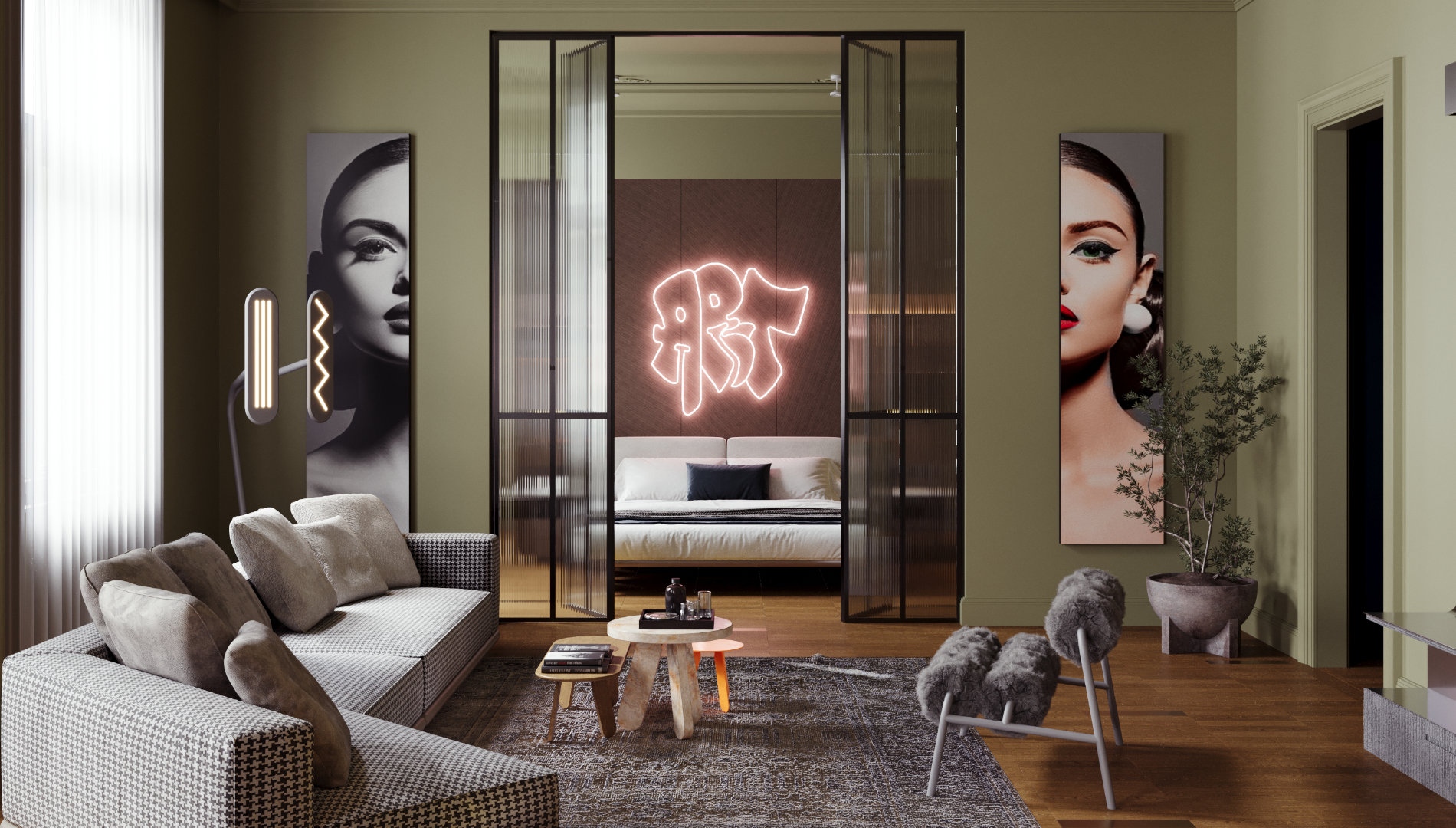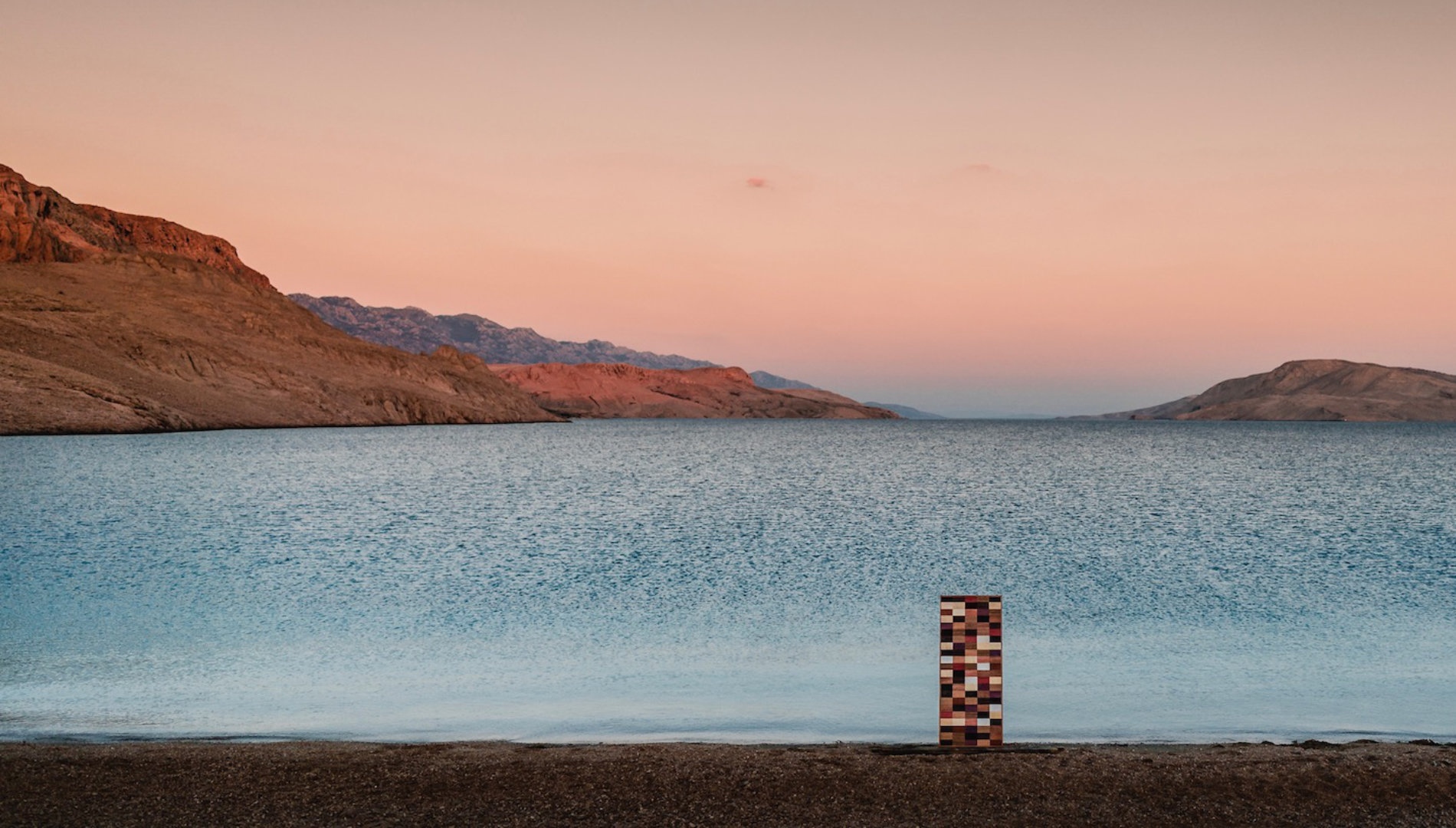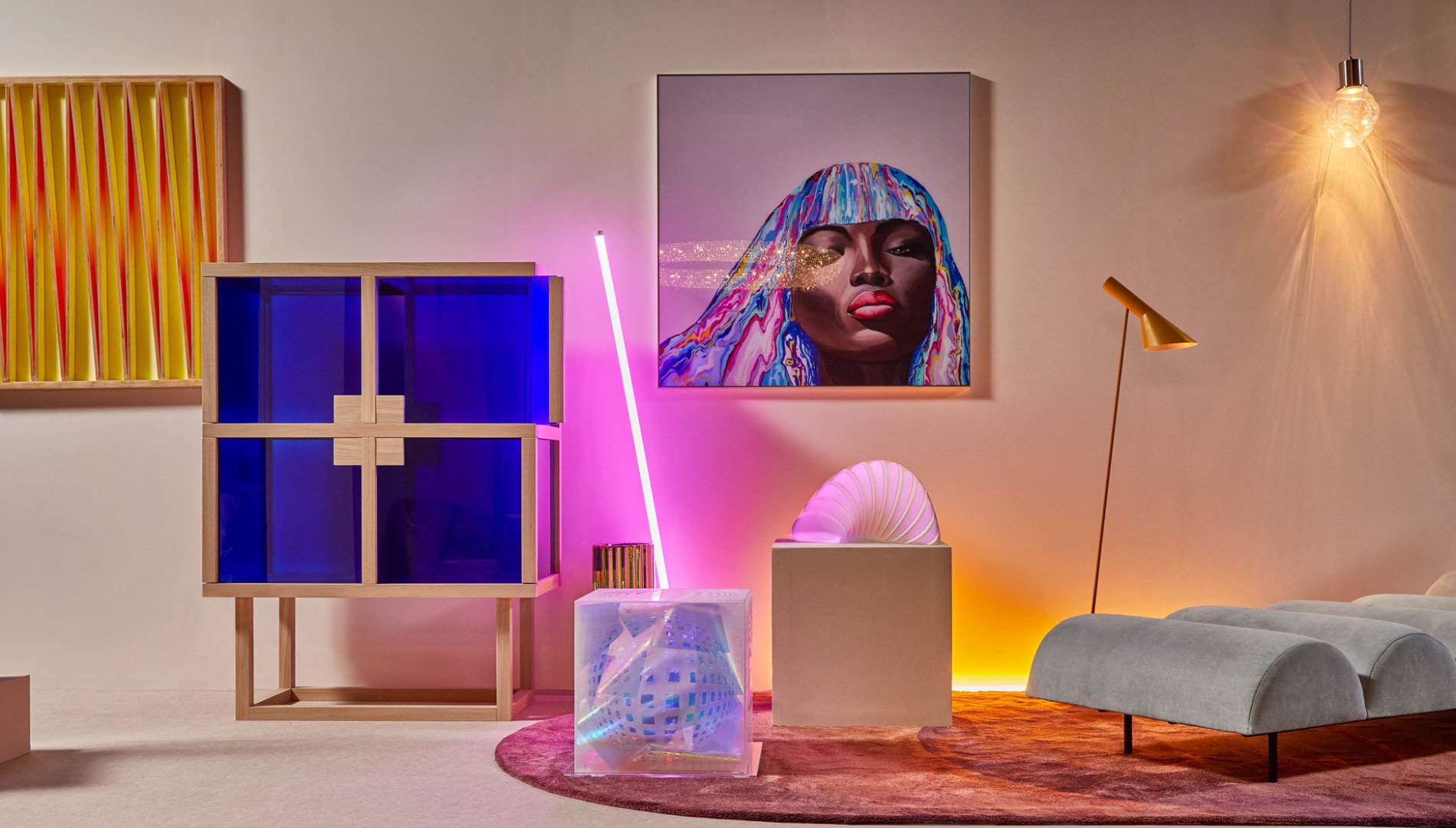
Show your true colors: S/ALON BUDAPEST Colorscope
Take a walk with us through the Colorscope interiors of S/ALON BUDAPEST 2022!
The curated spaces at this year’s S/ALON BUDAPEST mapped current trends through exciting color combinations. Interior stylist Kata Hortobágyi styled the Colorscope interiors, which occupied two sides of the exhibition space in an elongated layout, as fashionable displays with furniture, lamps and accessories. The inspiring installations were like moodboards coming to life, showing how a dominant color scheme or combination can be realized in a home in a form-defying yet harmonious way. The compositional details were not only artistic, but practical: the ideas on display can be used in a hallway, bedroom or living room.
The playful Vanilla to Mustard, soothing Blue, geometric Black & White, organic Marble green, subdued Beige, shimmering Golden dreams, rainbow Holographic and masculine Black installations included design pieces from international and local retailers and designers, as well as artworks.
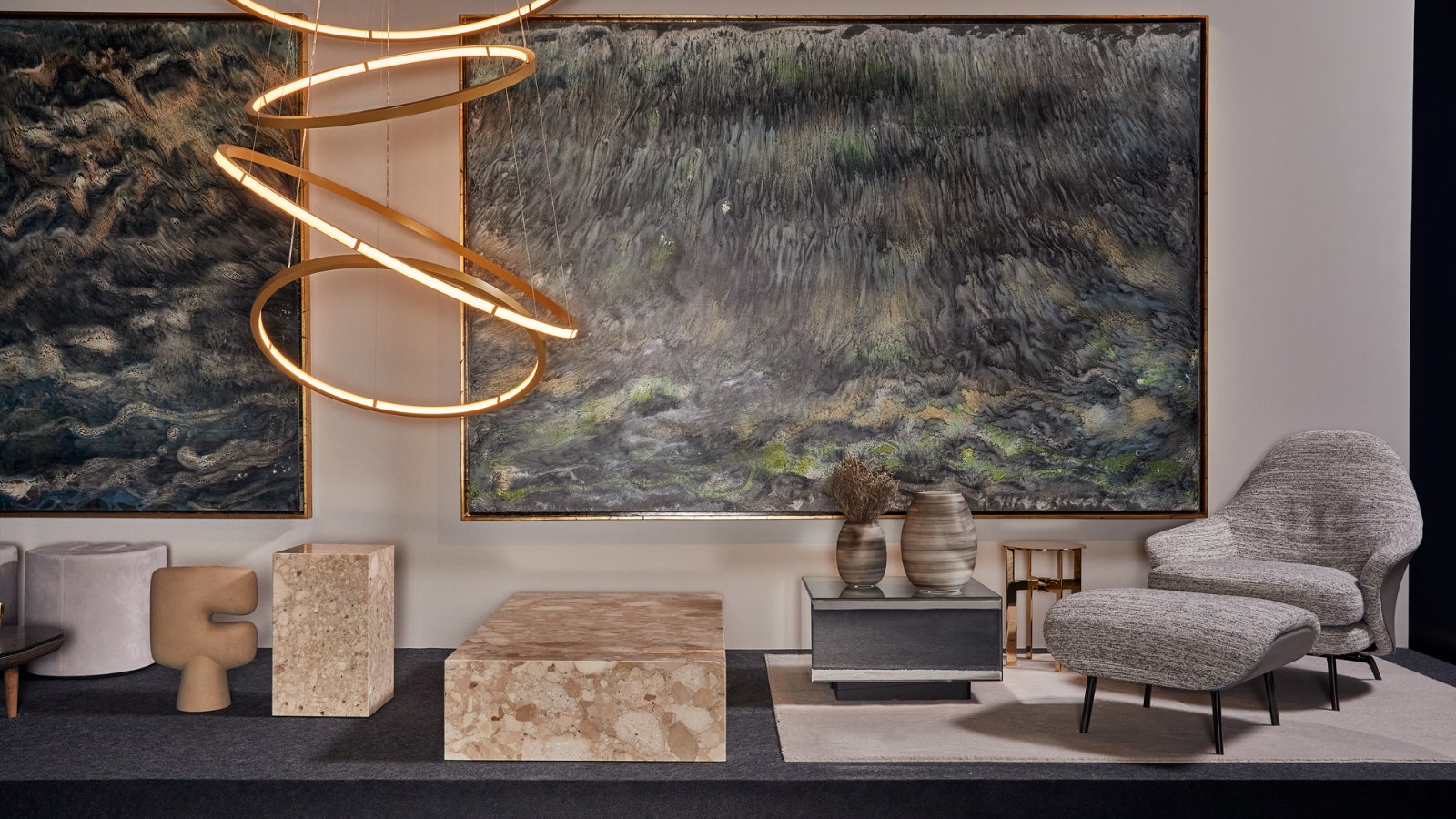
Are there any colors that are close to your heart? Wondering which premium brands have created a selection of progressive spaces? Did you like a design or artwork at the event but don’t know where to find it? Read on, our article has it all!
VANILLA TO MUSTARD
The bright and shiny yellow brings cheer and vibrancy to the space. Vanilla to mustard has refined this sparkling atmosphere with natural and brown tones. Reminiscent of the 1970s, the evocation of the past was given a modern twist, with familiar shapes and materials counterbalancing the stimulating color palette. The balance of classic and fresh, old and new - a sense of timeless design was palpable.
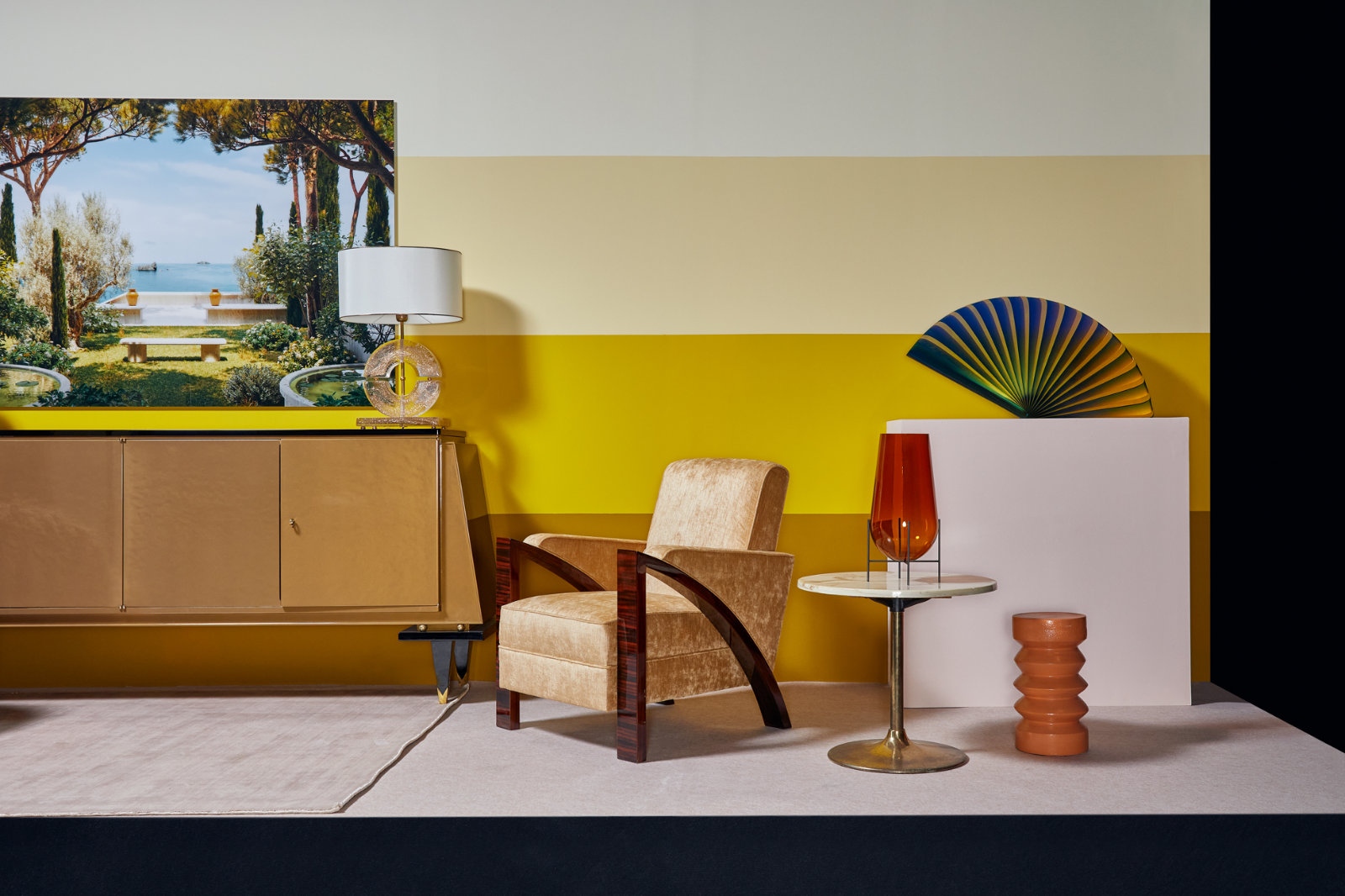
Ferenczy Noémi and Fujita Prize-winning glass sculptor László Lukácsi created his latest artwork for the event. S/ALON BUDAPEST was the first and last occasion to see Fan (2022) in Hungary: the sculpture moved to the United States after the event. Massimo Colonna’s Terrace Ravello (Lumas Gallery), on the other hand, invited on a nostalgic journey to the idealized Italian coastline, while the bonsai trees (Marczika Kertészet) tricks the passage of time by taming nature.

Kare Design’s furry Fluffy chair, Maxalto’s Caratos chair and footstool ensemble (CODE), and Artcore’s French art deco chair showcased the versatility of vintage single seating. Accessories with characterful solid or slender legs - B&B Italia’s Cesar footstool (CODE), Möbelkunst’s brass floor lamp and marble coffee table, Hephaistos’ bird lidded ceramics, light blue and celadon green lidded porcelain, a French sideboard and Murano glass table lamp by Artcore, a yellow Tortuga table by Ligne Roset from Sancal, and shell, peach and terracotta vases by HK living, an antique display box by Housedoktor, an Échasse vase by Menu and an Anong rug by Linie Design from Roomba Home Culture - all added a nice rhythm to the space.
BLUE
Blue used tones from the palette ranging from pale blue to saturated, intense royal blue. The calming effect of blue is undeniable, it can lower the heart rate and even slow down the metabolism. It creates a peaceful and authentic atmosphere, leaving room for honest reflection and creative ideas.
The high backrest Dedas chair of the latest Burnt Geometry collection from the domestic brand Line and Round helps to create this intimate atmosphere. Koinor’s Jetlag leather rocking chair (Sezlon Galéria) has a cloud-like design that makes it a comfortable center of reflection, while the airy yet sculptural Sancal Remnant armchair (Ligne Roset) brings a sense of elevation to the space. The Model 3101 chair (Möbelkunst), designed by Arne Jacobsen for Fritz Hansen takes us all the way back to the 1950s - the Danish design classic has lived on in the public consciousness as the Ant Chair ever since.
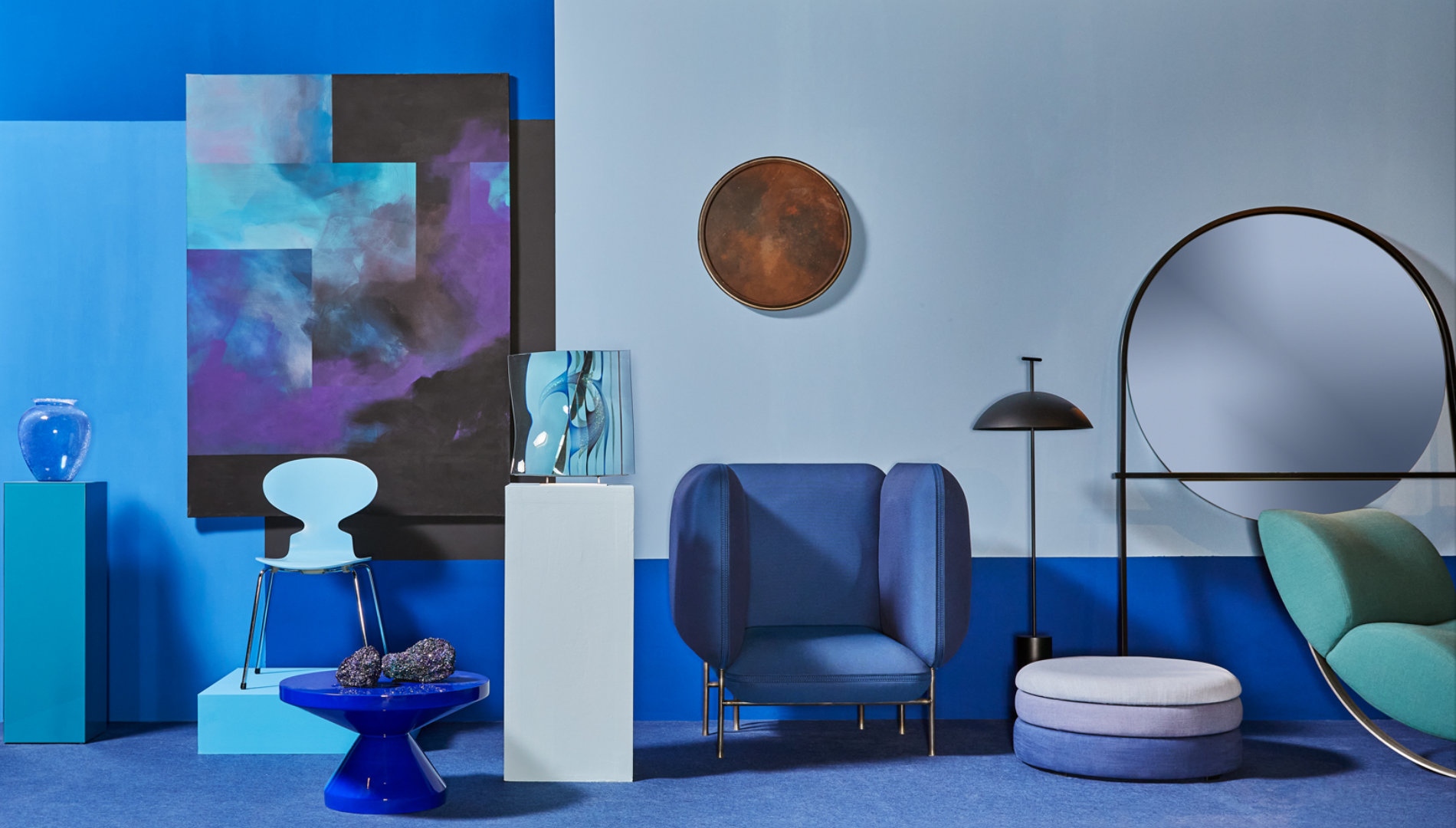
On the wall, Gábor Nagy’s circular, abstract work, called Csillagköd R1 (Youngart), is an attempt to capture the beauty of the universe. The painting by Balogh Gallus - Constant X. (Lavor Collective) uses artistic means and geometric lines to organize collective chaos. Dalma Göncz mixes stark concrete surfaces and feminine pigments with plastic imagery in Fictional Universe - New Galaxy II (Youngart), a painting highlighted by a single gray wall detail in the interior. The jewel in the collection of artworks was Amorf (2019), a glass sculpture by Péter Borkovics, courtesy of the Bohus-Lugossy Foundation / International Year of Glass.
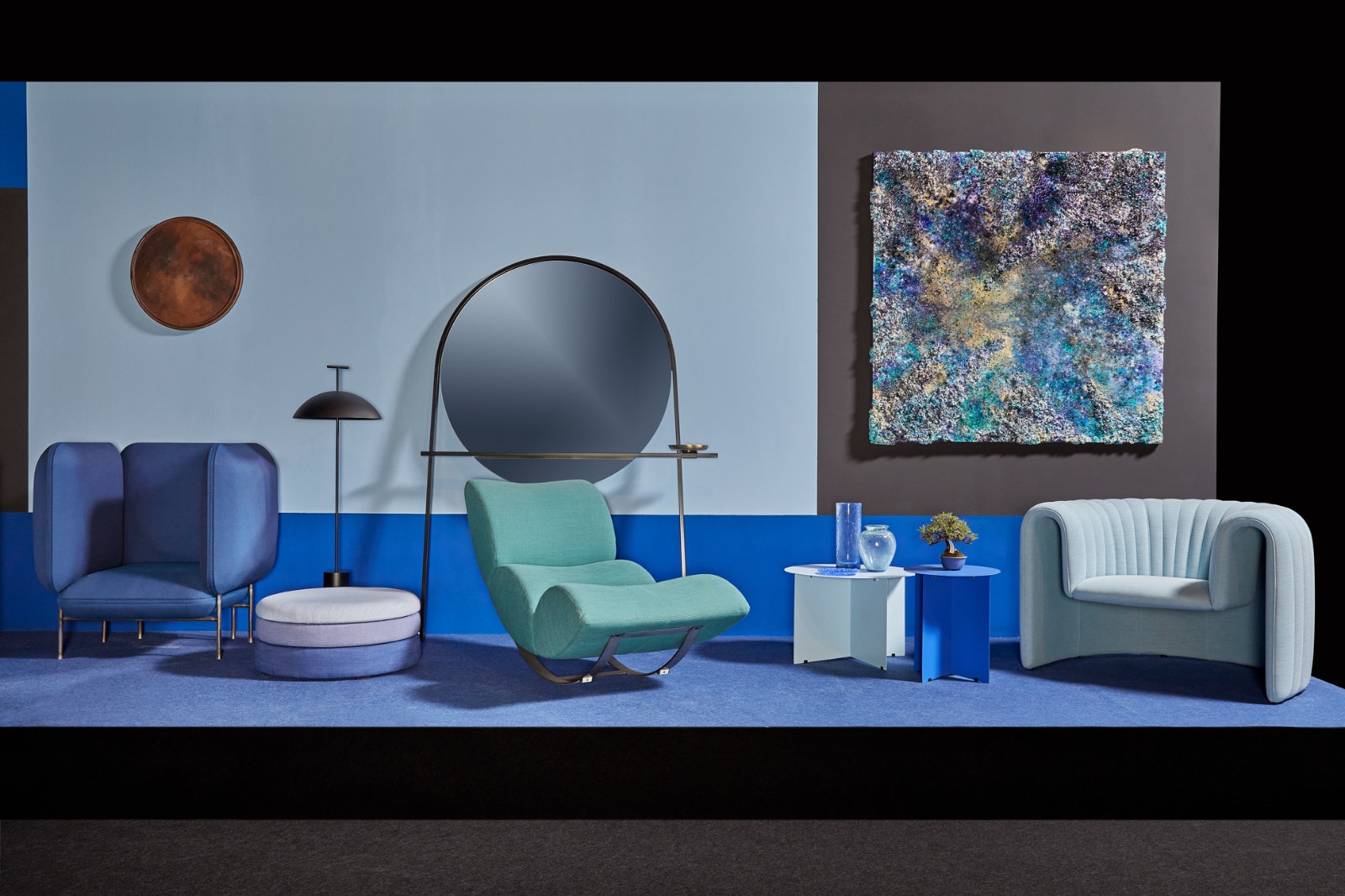
The inviting furniture is linked by the accessories: the Artcore blue Karcag glass vases, the Kartell GEEN-A floor lamp from Desidea, the blue and white porcelain from Hephaistos, the blue glass bowl by Márta Edőcs and the Geoffrey floor mirror from Ligne Roset. Roomba Home Culture has also raised the bar for interior design with a number of stand-out brands: a metallic dressing table and blue mirrored postamens from HK Living, a ZigZag side table from Pols Potter, color-transition cushions, a Sena cushion cover and a Magny vase from Broste Copenhagen.
BLACK & WHITE
In the Black & White space, optical illusions took center stage alongside the classic duo of black and white. Dorottya Hlakti’s unique Kamara wallpaper builds on the eye-deceptive tradition of trompe-l’œil, with the flexibly combinable elements of Cities and Signs influencing the sense of space through the seduction of the senses. Playing with shades of gray, the regular base is made more human by woven fixtures and yellow-beige tones, such as the modular Hannabi Box No34. sofa, HK Living Retro oval wardrobe and hand-woven striped rug (Roomba Home Culture) or NORR11 nomadic rattan lounge chair (Spirit Home). The subtle dynamism of the 101 Copenhagen Drop chandelier (Roomba Home Culture) with its slightly curved adjustable arms also brought life to the installation.
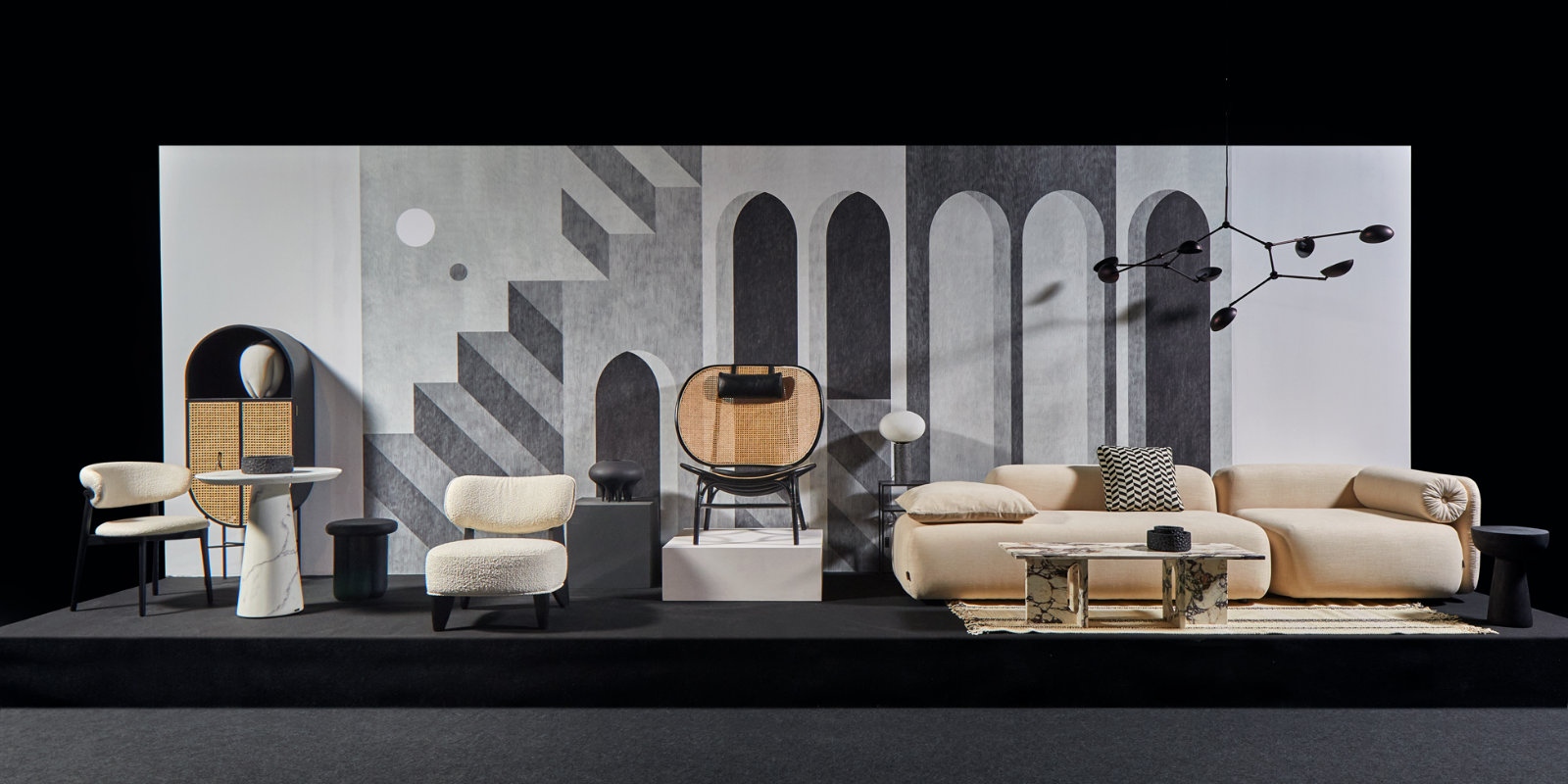
The tables and accessories, with their clean lines, attracted attention not with their colors but with their premium materials and pleasing lines. The Cloud glass vase from HK Living, the Phant coffee table and seat, the Opal table lamp and cushion from Housedoctor, the marble-effect round table from Pols Potten, the Medusa and Sumo vases from 101 Copenhagen and the Androgyne marble coffee table from Menu arrived from Roomba Home Culture. Spirit Home’s Juna bouclé upholstered lounge chair and Ethnicraft Chopped wooden bowl set, Mobili Mania’s Kubus bowl and vase, TH Design’s SAS 008 black small lounger and Calligaris Oleandro chair, and Vákum Design’s CustomForm Tensio 30 lounger table also made an appearance in the space.
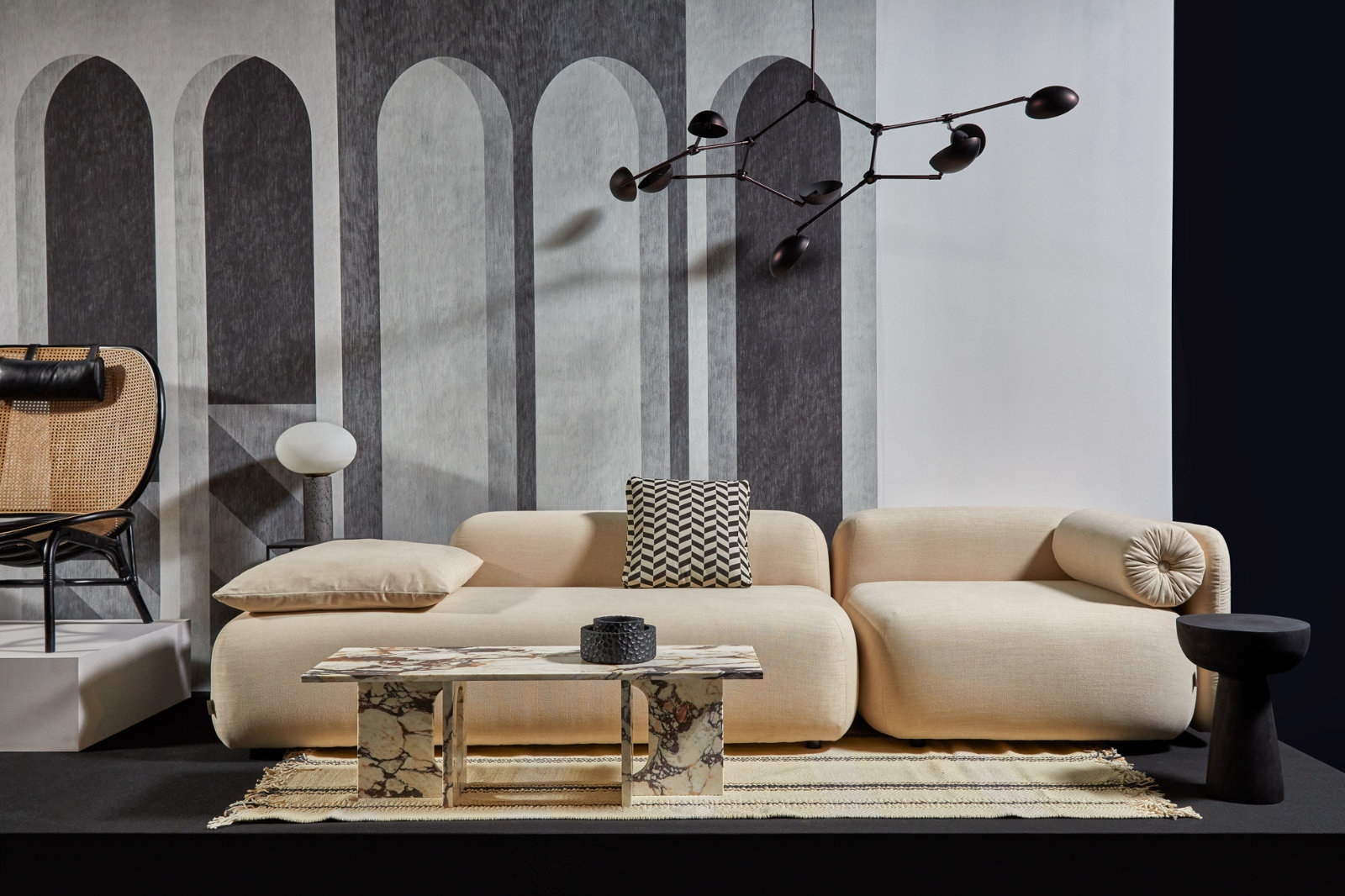
MARBLE GREEN
The main source of inspiration for Marble Green was nature, which was reflected in the shapes and colors, in addition to the organic materials. The name is a reference to the dominant Wall Concept Marble Dreams (300447) wallpaper, highlighting nature’s primary color, green, whose richness was presented not only on the wall but also on the furniture and accessories.

The mint-green Pols Potten Desk (CODE) and Luca Kohut-Görömbei’s Hope of Spring plates (2021) represented the fresher shades of the spectrum, while Menu’s Eave Modular sofa (Basic Collection) was a more earthy, brown-tinged version, similar to the space’s wooden objects. The Jomain Baumann screen from the 1940s (Artcore), the Asbeak shelf (ID Design), the Tree table lamp (Lightcore Studio), the Deneb square wooden table with glass top, the Rigel round small table, the wooden wall art and vases (The Matthiew Kiss) all flashed stylish slices of the infinite possibilities of wood, while the bonsai (Marczika Kertészet) demonstrated the unparalleled impact of living plants.
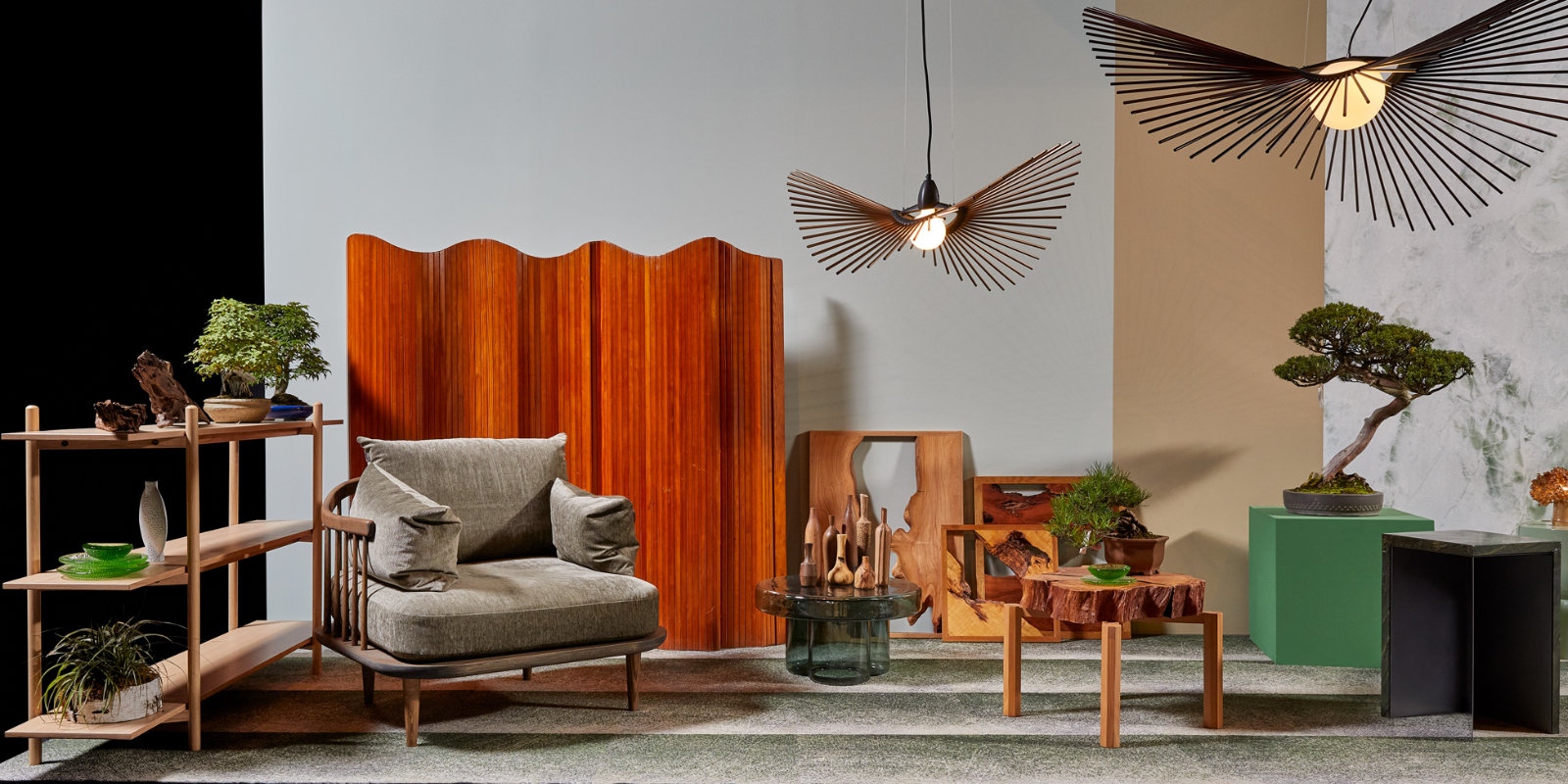
Other natural or natural-inspired materials were also used in the space, such as Broste Copenhagen’s Andrea leather cushion (Roomba Home Culture), Zsuzsanna Sinkovits’ Alföld vase from the Geoform ceramics collection, Milliken’s Coastline modular floor mat (Andrea Darabos) and the &Tradition Fly armchair (Basic Collection). Pols Potten’s Nougat coffee table (Roomba Home Culture) represented terrazzo, Architres Studio’s REBLE Table R table represented marble and Miniforms’ Soda small table (Basic Collection) represented glass. The installation was embraced by Loomiosa’s airy Model 8 lamps, similarly inspired by nature.
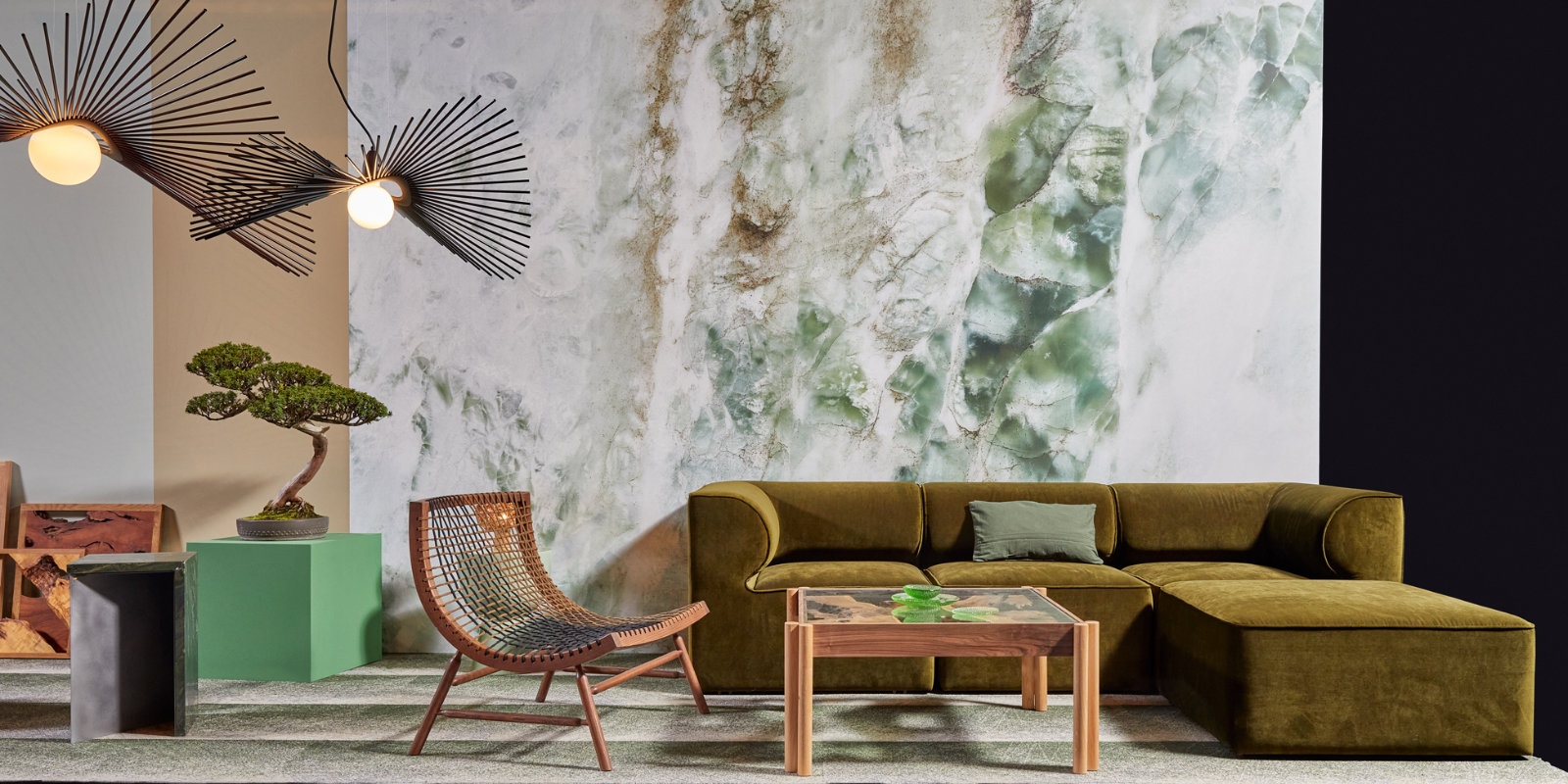
BEIGE
Although Beige’s dominant colors were the relatively neutral beige and gray, the space was not lacking in vibrancy thanks to Márta Kucsora’s mesmerizing untitled paintings (2021), the Oleant Olala Combo lamps and the exciting design of the furniture and accessories. Márta Kucsora is an internationally renowned and acclaimed contemporary artist, her expressive paintings invite us into an immersive world of monumental abstraction. Beige demonstrates an approach to interior design that sees artwork not as accessories to be aligned to furniture, but as an elemental cornerstone that organizes space.
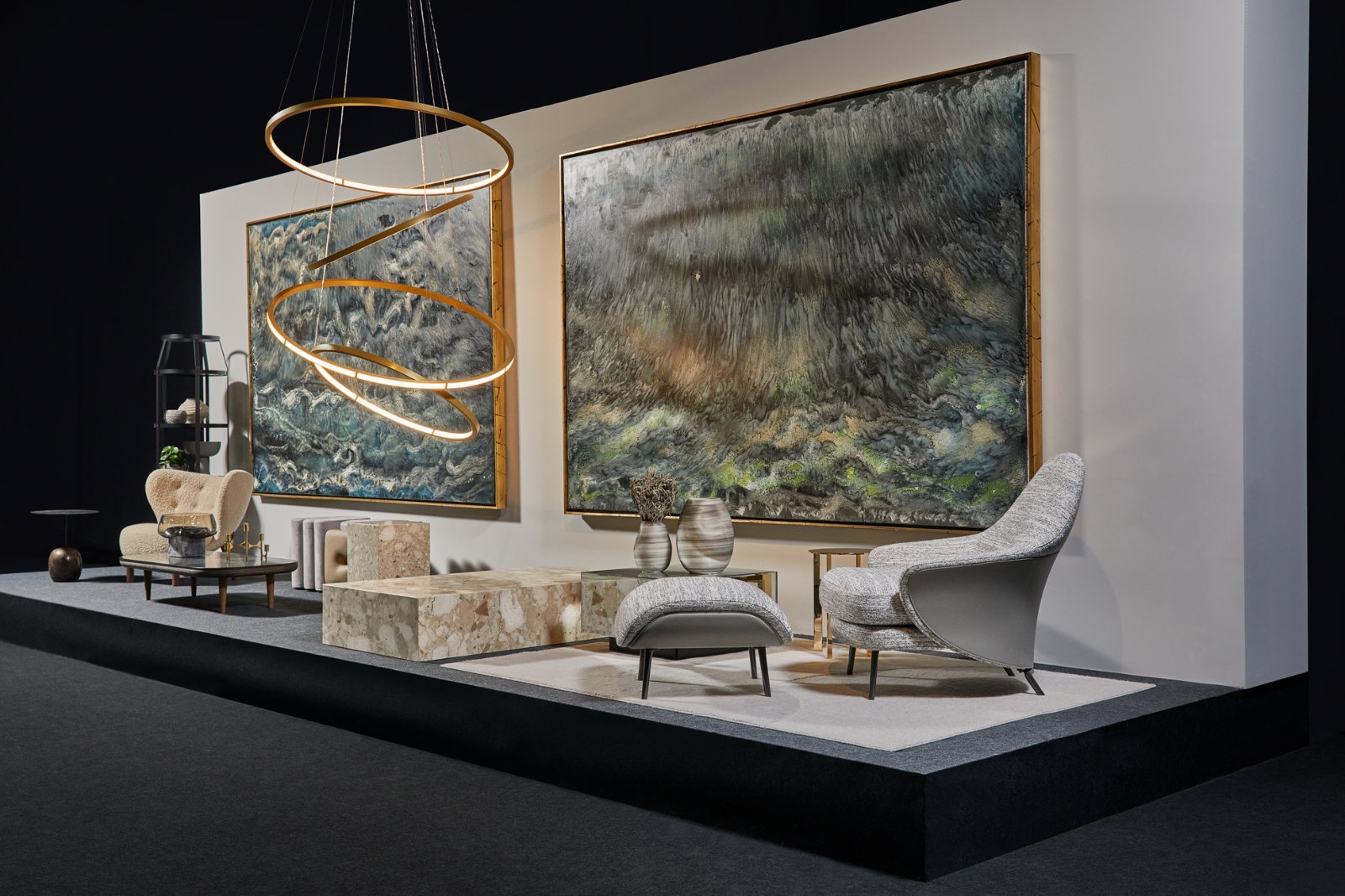
The Baxter Adel poufs, Menu Plinth stone tables, 101 Copenhagen Tribal vase, Linie Design Simplicity rug, HK Living low mirrored table and Mitrani Gravity Cube bowl from Roomba Home Culture were added to the space, along with the &Tradition Little Petra armchair, Fly coffee table and Lato small table from the Basic Collection, the Grey bowl, manger and Dream rug from ID Design, the Pression vases and Babele high-reaching cylinder shelf from Ligne Roset, and the Minotti Angie armchair and Ellis gold storage from CODE Showroom.
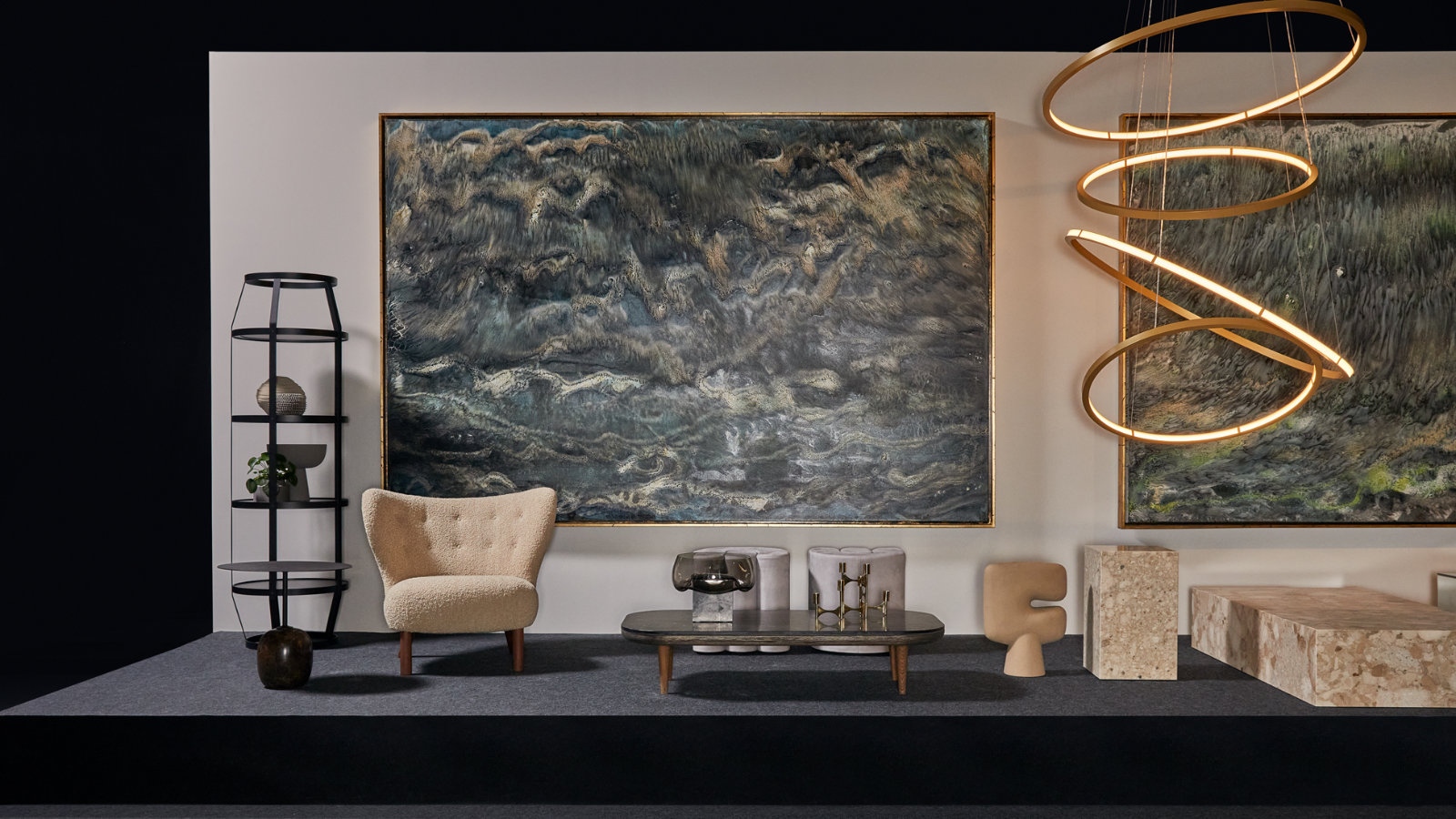
GOLDEN DREAMS
Golden Dreams combined elegant, seductively warm tones of gold and golden brown with white and beige, giving a more restrained, understated version of the bourgeois and art deco styles. Wall Concept’s Tropical Treasure (300397) and Renee Pearl (30589) wallpapers set the tone for the space, offering an alternative for those who prefer both organic textures and figurative wall coverings.
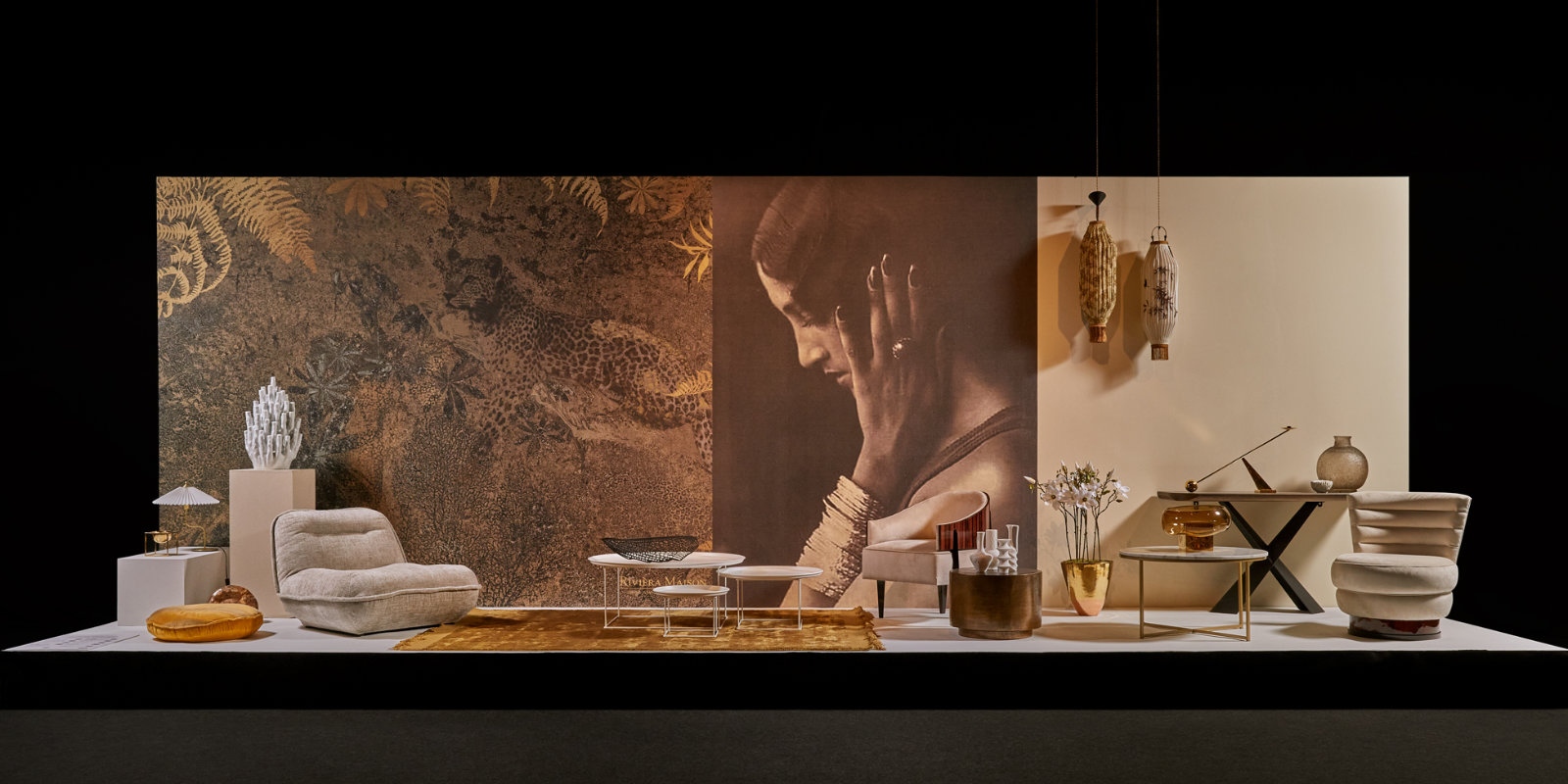
Roomba Home Culture is also represented in this installation with a number of cutting-edge brands. The Valence rug is from Linie Design, the Interconnect candleholder is from Menu, the puff lounge chair and Coral vase are from Pols Potten, the antiqued bronze table is from Housedoctor, the traditional paper lanterns, striped seat cushion and white porcelain vases are from HK Living, and the Gravity Cube bowl is from the Mitrani collection.
Artcore brought in French chairs from the 50s and the golden age of Art Deco, and added an Art Deco style vase, along with a sculptural ammonite fossil. The combination of the CODE Showroom BB Italia Fat-fat coffee table, the ID Design Alisma round marble and brass coffee table and the TH Design Terminal Keramik Premium console table with its varied weights and heights provided the inspiration for a practical and dynamic storage system. The Arioso gold planter and faux plant, the Hephaistos gold porcelain litter tray and the Mobili Mania Kubus gold bowl added the essential metallic shimmer and decorative detail to the space, while Nóra Szirmai’s Beauty of Destruction No. 5 (Youngart) conceptual abstract sculpture seasoned it with a contemporary flavor.
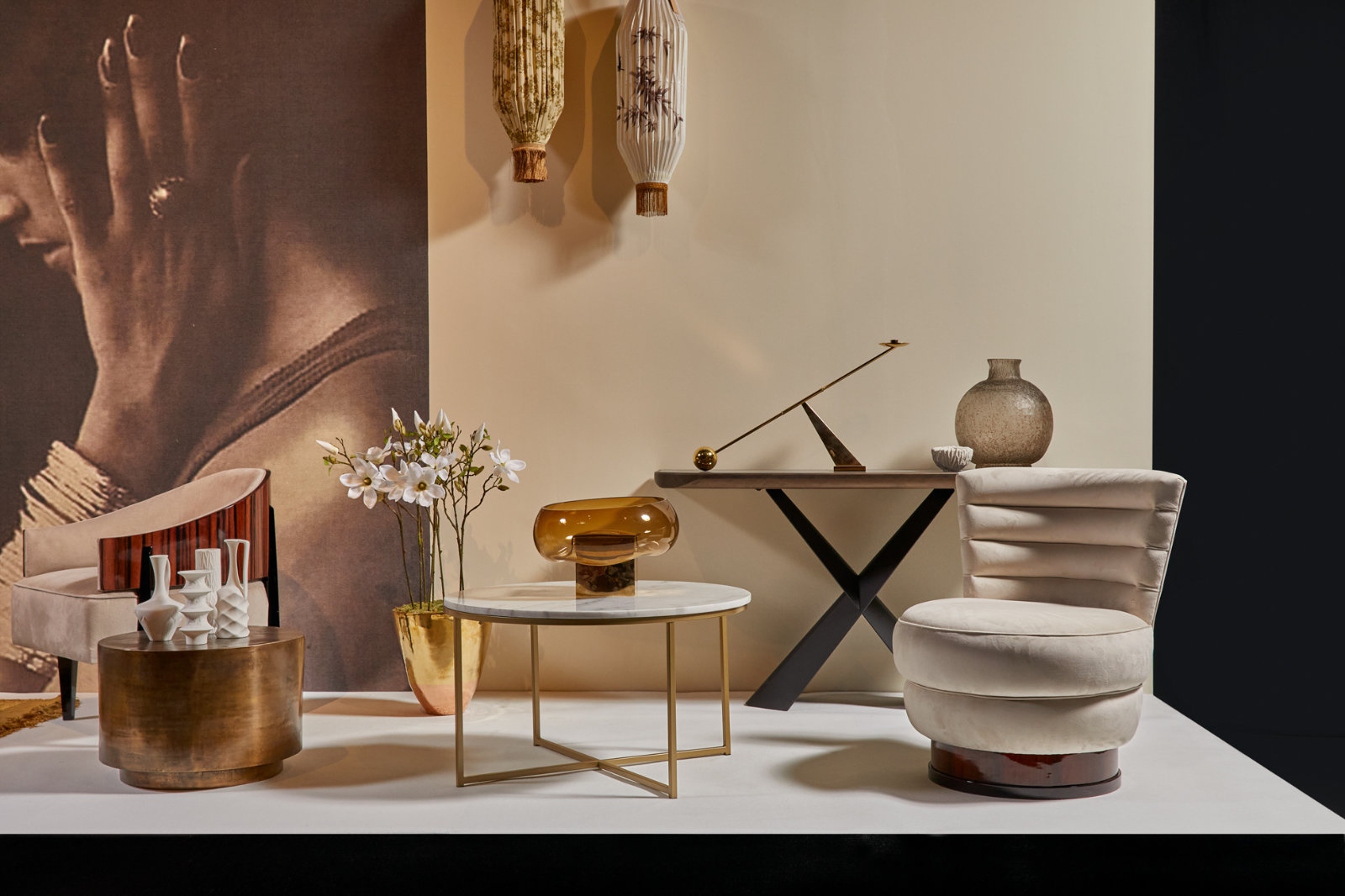
HOLOGRAPHIC
In the Holographic installation, we unleashed our energy and imagination - instead of one or two dominant colors, we used iridescent surfaces, furniture and lighting fixtures in all the colors of the rainbow.
As for the name: did you know that the Hungarian-born physicist Dénes Gábor was awarded the Nobel Prize in Physics in 1971 for the invention and development of the holographic method? Holography is an imaging technique based on the wave nature of light to create a perfect three-dimensional image of the structure of an object. Without going into the scientific discoveries, applications and theories associated with the concept, its perspective-broadening essence is evident.
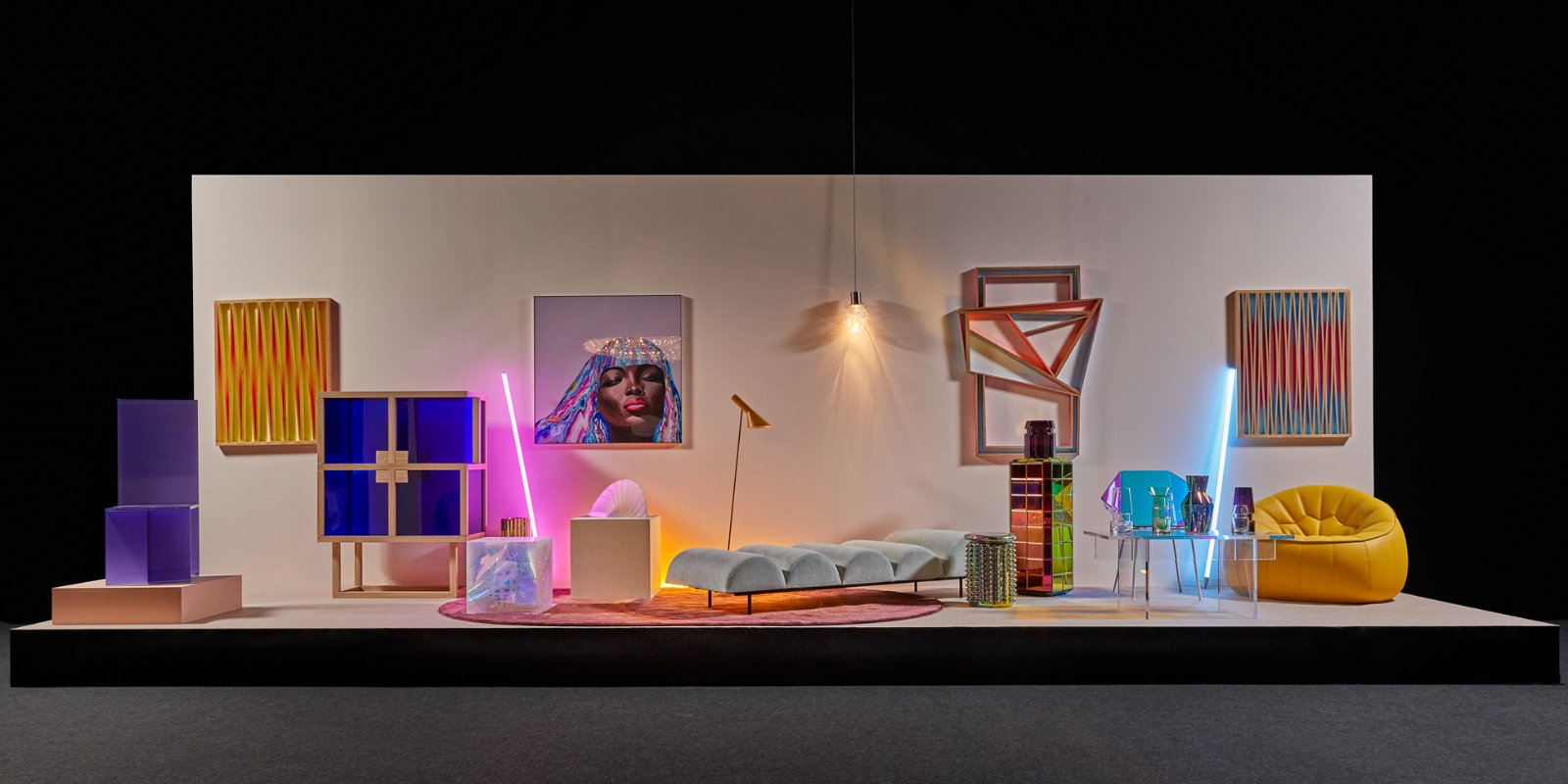
The "star guest" of Holographic came from the Netherlands to S/ALON BUDAPEST. Elise Luttik’s transparent Prismania chair is both an art object and a seat: it is barely noticeable from a certain point, but if you take another step, it reveals all the colors of the spectrum. The space was framed by two equally form-fitting chairs: the Merci Bob chair (CODE) from Glas Italia bonded coloured glass on the left, in purple, and the Ligne Roset Ottoman yellow leather chair on the right, completing the composition. In the center was the postmodern science fiction-inspired Námi sofa from Hungarian brand NORNA, and next to it was the Pols Potten psychedelic Oily Spike seat (Roomba Home Culture), a real statement piece. Roomba Home Culture’s futuristic Pols Potten selection also included the Oily Folds vases, Yourtube gold vase, Oval Optical rug, Pixel Column and Twister light fixture. Illuminating solutions were provided by the Louis Poulsen AJ floor lamp (Desidea), the Glasblase pendant lamp (Innoconcept), the Schneider Electric color socket and the Hay coloured neon tubes (Solinfo Group).

On the wall, Yeliza’s First Love painting (Lumas Galéria) depicted a radiant female face, while the abstract paintings were by Anthony Vasquez, a multidisciplinary artist who has moved to Hungary from the United States (First Light of the Morning, You ’re still my Sunshine, DJ Play my song).
On the Plexiglass coffee table (CODE) of Gáspár Bonta, the latest frame collection by Daniella Koós, sponsored by Varga Kristály, was presented. The designer’s other novelty, the HILO display cabinet, was also the result of a fruitful collaboration, sponsored by Rákosy Glass. In addition to the outstanding glass design objects, you could also encounter glass artworks in the space: the sculpture Szirmok (2022) by László Lukácsi and Vasarely Titka (2022) by Dorka Borbás.
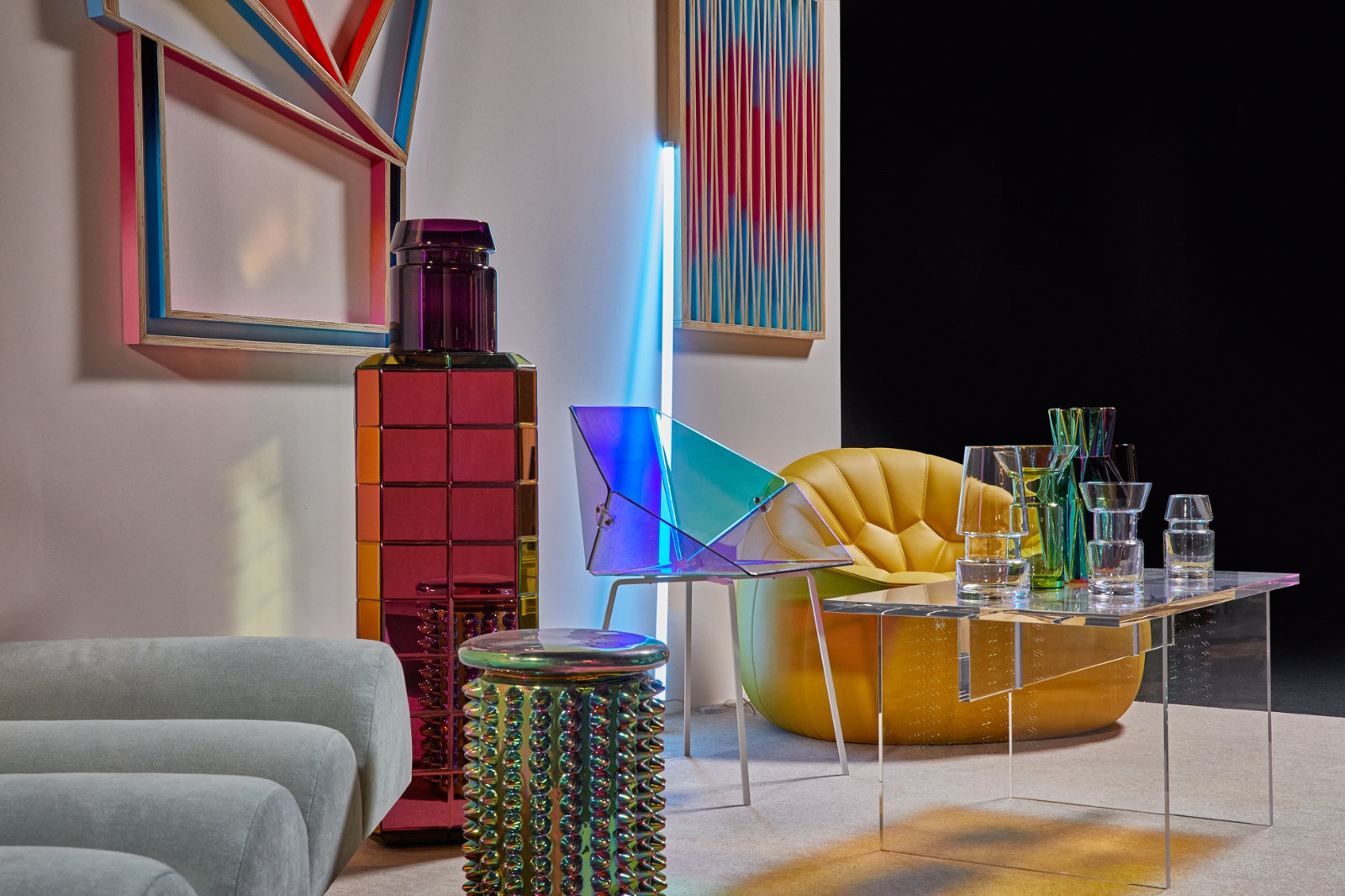
BLACK
The powerful black can also be interpreted as a symbol of strength, formal elegance and mystery, but one thing is for sure: it guarantees a striking, dramatic effect. In dark interiors, the eye searches for reference points, making textures even more distinctive. Black can also be combined with accent colors, simple geometric lines or striking lighting fixtures such as the Manooi Hanabi Star crystal chandelier, but the &Tradition Flowerpot table lamp VP3 (Mobili Mania) and the Flos Captain Flint Floor floor lamp (TH Design) are also excellent choices for this masculine mix. The colorful lines on the wall are in harmony with PAF’s (Youngart) abstract paintings (9090_41, 3030_44, 3030_42, 3030_66).
The iconic three-seater Maralunga leather sofa (Möbelkunst), designed by Vico Magistretti, was born in the 1970s in the Cassina workshop in the spirit of maximum comfort, just as the Ligne Roset PaiPai armchair, situated in the right of the space, embraces its user almost like a cocoon of silk. When the ideal sitting position is the goal, rather than a comfortable slump, the Bla Station Lucky B17 chair (Mobili Mania) is always a suitable solution.
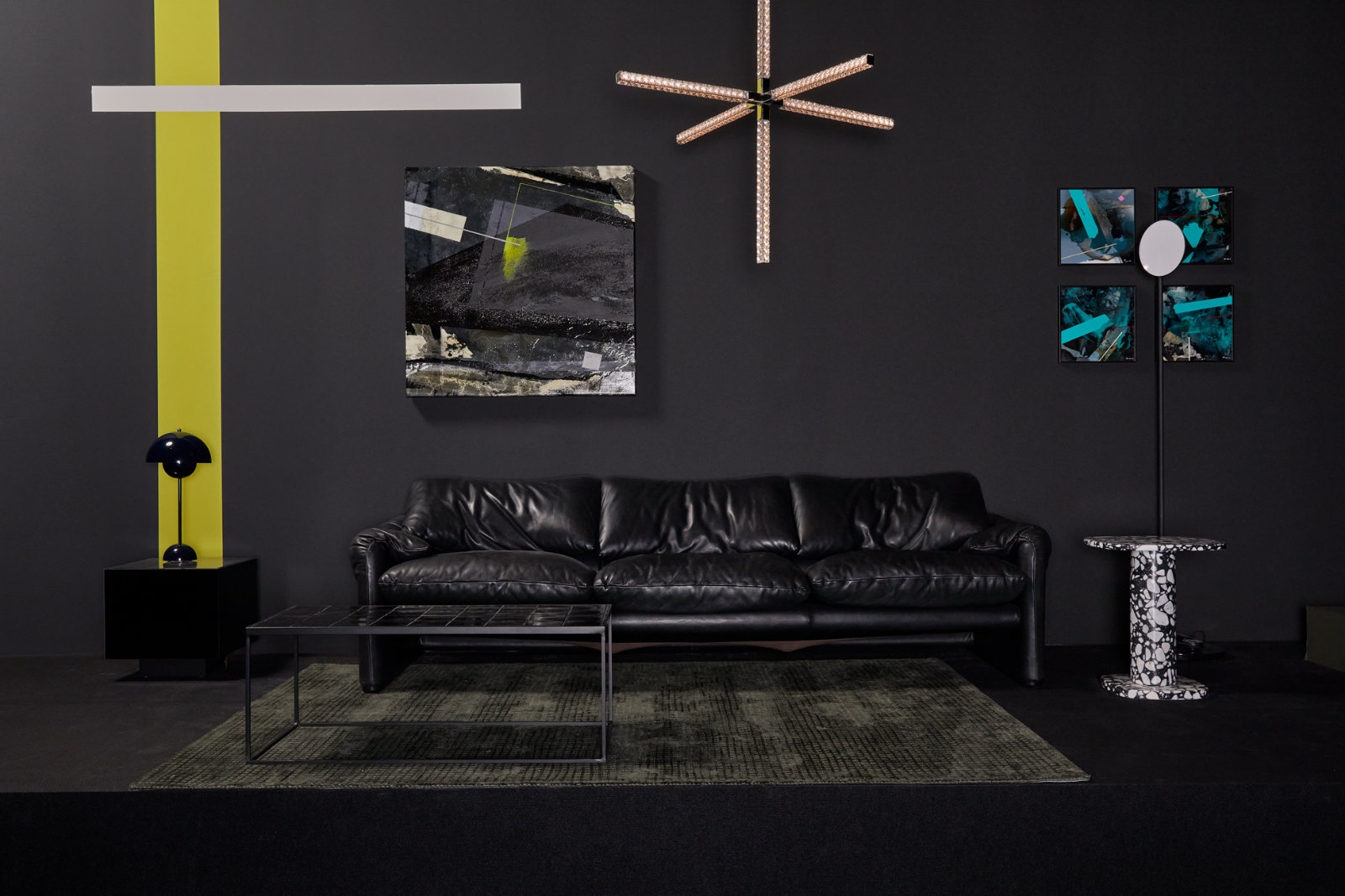
Some accessories deepened the blackness, some loosened it a little. In addition to Artcore’s minerals, there was a yellow Karcag vase and black and white ceramic vases from the 1970s, a Glazed coffee table and Rina rug from ID Design, a Cube bowl and vase from Mobili Mania by Lassen, a Cattelan Italia Nautilus bookcase from TH DESIGN, a black mirrored table from HK Living, an offset vase and Duck tray from 101 Copenhagen, and a Yourtube vase and Twister small table from Pols Potten from Roomba Home Culture.
We look forward to seeing the major trends of 2023, which we can bring to the Budapest Arena from 22-24 September. In the meantime, stay tuned here on the blog for more behind-the-scenes content, interesting and useful details! And on Facebook and Instagram, you can not only browse through the list of partners and objects in our curated spaces, but we’ll also be gradually working through the rest of the interiors of this year’s event.

